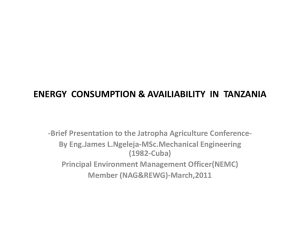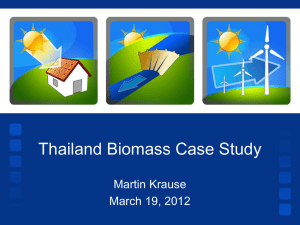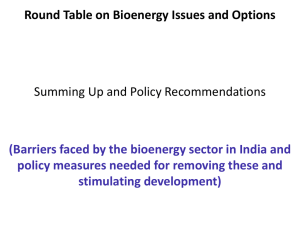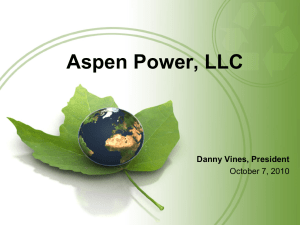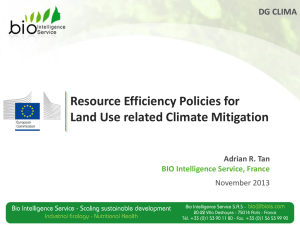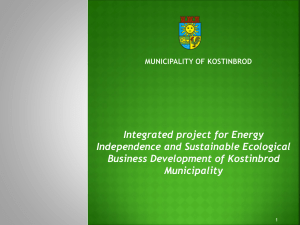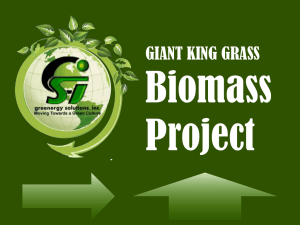Components of perennial biomass projects
advertisement
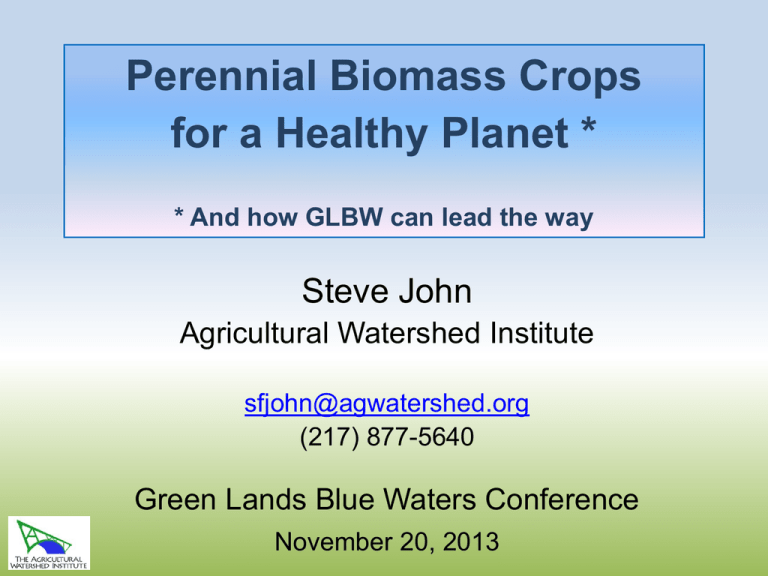
Perennial Biomass Crops for a Healthy Planet * * And how GLBW can lead the way Steve John Agricultural Watershed Institute sfjohn@agwatershed.org (217) 877-5640 Green Lands Blue Waters Conference November 20, 2013 Perennial Biomass Crops •Switchgrass •Miscanthus •Other grasses •Prairie polycultures •Willows & other SRC trees Today → heat, electricity, forage Tomorrow → cellulosic biofuels Components of perennial biomass projects: 1. Outreach & assistance to early adopters Some landowners like the “GYOF” idea – Grow your own fuel! Caterpillar – AWI Prairie for Bioenergy Demonstration Plots Planted Spring 2011 Switchgrass harvested August 2012 Components of perennial biomass projects: 2. Market and enterprise development Markets for biomass ~ and ~ Compensation for ecosystem services Eastern Illinois University’s Renewable Energy Center burns wood chips during start-up period. May shift to a grass—wood blend. Community Supported Energy • Grow energy crop • Densify into pellets or briquettes • Deliver biomass fuel to customers • Collect ash & return nutrients to the soil A-Maiz-ing Heat Furnace Buskirk Densification System L Meschke Photo Madelia Model: Perennial Feedstocks to Advanced Biofuel Goal: Utilize Local Grown Renewable Energy as a Catalyst for Increasing Perennials on the Landscape to Reduce Pollution from Production Agriculture Madelia slldes: Linda Meschke, Rural Advantage Examples of energy conversion technologies used or proposed for perennial grass biomass • Pellets or briquettes for heat or power: o o o o o Hudson Valley Grass Energy (NY) Piedmont Geriatric Hospital (VA) – (Burns undensified chopped grass) N.E. Poconos RC&D / Benton School District (PA) Agrecol (WI) Show Me Energy Cooperative (MO) • I. Torrefaction → II. Syngas → III. Liquid biofuel o Rural Advantage – Madelia Model (MN) • Drop-in gasoline or jet fuel: o Show Me Energy Cooperative (MO) o Cool Planet Energy Systems • Anaerobic digesters w/grass biomass: o Roeslein Alternative Energy / Midwest Conservation Biomass Alliance Components of perennial biomass projects: 3. Develop and demonstrate landscape design concepts: Optimize co-production of biomass & environmental benefits •Water Quality •Biodiversity •Wildlife habitat •GHG reduction Prairie grass buffer separating an organic field from the adjacent conventionally-farmed field. Forb Dominated Field Borders & Drive Rows • Maximize Wildlife Benefit & Reduce Equipment Damage FDC Enterprises is developing and field testing production and logistics concepts for perennial grass biomass. Design/Planning Workshops: Visualizing Agricultural Landscapes • Visualizations and models show appearance & quantify production and conservation from possible landscape designs • Shared evaluation of these designs to sort through options, win-wins, tradeoffs… Credit: Nick Jordan – Seven Mile Creek Biomass Production Planning Project Perennial biomass crops on Central Illinois farms Macon County – Perennial crops will be planted on a sloping site for forage and enhanced water quality: • Alfalfa • Eastern gamagrass • Warm season grass mix As markets develop, grasses and alfalfa stems may be used as feedstock for bioenergy or bioproducts. Mixed warm season grasses Eastern gamagrass Riparian buffer Saturated buffer concept: Tile flow is diverted to soil column under buffer. Nitrates removed via plant uptake and denitrification. “Lost” nutrients could fertilize a perennial biomass crop. Drainage discharge pipe Diverter box Adapted from Dan Jaynes, USDA, 2009. Field Economic model projections of biomass energy generally appear to omit consideration of benefits. Would placing values on soil, water, wildlife and GHG benefits lead to a bigger biomass wedge? Bloomberg New Energy Finance projections of annual installations of new power sources Potential Ecological Uplifts: Sediment, N & P Reduction Water Storage Increased Wildlife & Pollinator Habitat Carbon Sequestered GHG Reduced Less Production/ Input Costs Payment at least as good as Corn/Soybeans Biomass Production Payment from the Energy Facility Ecological Uplift Payment Targeted to Marginal Lands* * Compare economics of corn production on marginal lands to dedicated energy crop economics. USDA – NRCS Photo Crop Area Harvested (1000 ha) Upper Midwest Crop Area 25000 Transition to grain-only farming: ~1950-1970 Nitrogen fertilizer production begins 1947 20000 Corn 15000 Soybean Hay 10000 Wheat Wheat 5000 Oat 0 1920 1940 1960 1980 2000 Key messages for perennial biomass Biomass crops are the only source of renewable energy that can provide landscape-scale ecological benefits → clean water, wildlife habitat, GHG reduction, soil health … Fossil fuels cost less than perennial biomass because the environmental goods of perennials and the environmental bads of fossil fuels are ignored. Climate change, the shift toward renewables, and Gulf hypoxia may be drivers of change on a par with the introduction of inorganic fertilizer after WW II. GLBW has the vision & expertise to help guide this transformation. We should have a sense of urgency to overcome the barriers.



